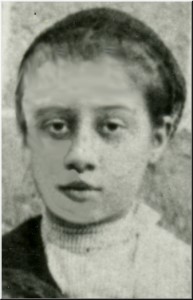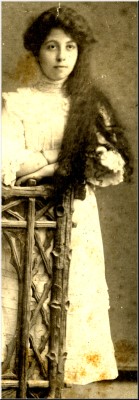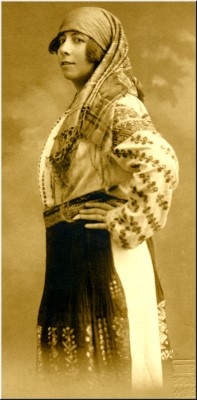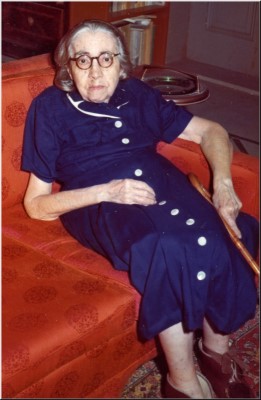Biography
The late Marie Chiha Hadad was born in 1889 in Beirut, Lebanon to a prominent family of bankers. She completed her education in 1908 at the exclusive French school ‘l’Ecole Des Dames De Nazareth,’ where she studied the work of the French masters in both literature and arts. Marie Chiha was married to Georges Hadad in 1916. The couple had three daughters, Magda (1918 – 1945), Andree (1919 – 1995) and Zeina (1922-).
In the early 1920’s, Marie Hadad began painting for her own pleasure since it was not proper for Lebanese girls to undertake any manner of work. She had some art training in 1924 and 1925 with the French artist, Kober, who had an art school in Beirut. Subsequently, in 1930 she began exhibiting her art in Beirut and quickly became famous for her enduring and passionate portraits of bedouins and Lebanese highlanders. She truly earned her nickname of “the bedouin’s artist”
In 1933, her friend Le Comte De Martel, French Ambassador to Lebanon, invited Marie Hadad to show her work in Paris. Hadad was the first and only Lebanese artist to be admitted at ‘Le Salon d’Automne Du Grand Palais’ in Paris from 1933 until 1937.
Her first solo exhibition was held at Georges Bernheim Gallery in 1933 where she continued to exhibit every year until 1940, the beginning of World War II. In fact, the French government acquired two of her portraits. The artist also exhibited in London and New York and took part in the New York World’s Fair of 1939 and the Cleveland International Exhibition of 1941.
Hadad was also a proficient writer; in 1937 she published a collection of short stories entitled “Les Heures Libanaises” in which many of her paintings are reproduced.



Marie Chiha Hadad was a leader and pioneer in the Lebanese art circle and headed the “Association des Artistes du Liban.” Her salon was famous as a meeting place for Beirut’s intellectuals and artists. In 1945, while the world celebrated the end of the war, Marie Hadad endured the tragic death of her daughter Magda. This marked a turning point in her life. She abandoned her painting and went into seclusion until her death in 1973.

About art, Marie Hadad noted:
“Art colors our lives and enlightens us with beautiful illusions.”
M. Joakim
Dream :
I dreamt that Life was beautiful with marvelous gardens and kind and good inhabitants. I dreamt that I had wings, traveling through space, without pain or tiredness, and that I was satisfying an infinite thirst for seeing and knowing.
I dreamt that everything was mine; the hereafter was my country, my homeland, my domain. I was lightly touching the stars, kissing the snow. I was meeting majestic and serene eagles. Cedars were delightful dwarfs. Winds were no more adverse, the raging elements of nature were miraculously in harmony.
I was enveloped in ideal light, brilliant and soothing like twilights without sun. It was clarity, it was happiness.
I was remembering a world where ugly souls were concealed inside bodies, and sometimes this was filtering trough everything they said and done. I felt pity for these beings because they had so many reasons to suffer. Nothing makes human beings suffer more than their own flaws; it’s like inside spines that would prick with each bad thought.
I dreamt I had no need, no worry. I was eternally satisfied; I had eaten a fruit that would be forever sufficient. At the same time it quenched my thirst and its effect would last as long as times would last. I did not fear cold or heat. My body, where was he? I only felt a free soul.
I did not hear any music, but some waves were propagating harmonies, among which I was, vibrating so much from the inside.
My youth was eternal, my power to enjoy unlimited, and I was filled with everything.
Earthly torment, worry, you had abandoned me. I was in love with all souls; they were all just beautiful.
But the dream is over and I came back from a short escape. I’ve found my body back like we find a coat again in a cloakroom. And each day I come closer to another escape, and this one is without return.
Marie Hadad
Extract from “Lebanese hours”
“The Phoenician magazine” Publishing – Museum square – Beirut 1937
Rêve :
J’ai rêvé que la vie était belle avec des jardins merveilleux et des habitants aimables et bons. J’ai rêvé que j’avais des ailes, que je voyageais dans l’espace, sans heurt, ni fatigue, et que je rassasiais une soif infinie de voir et de connaître.
J’ai rêvé que tout était à moi ; l’au-delà était mon pays, ma patrie, mon domaine. Je frôlais les étoiles, je baisais les neiges. Je rencontrais des aigles majestueux et sereins. Les cèdres étaient de délicieux petits nains. Les vents ne se contrariaient plus, les éléments déchaînés de la nature étaient miraculeusement d’accord.
Une lumière idéale m’enveloppait, éclatante et reposante, comme les crépuscules sans soleil. C’était de la clarté, c’était du bonheur.
Je me rappelais un monde, où les corps cachaient de vilaines âmes, qui transparaissaient quelquefois dans les faits et gestes des hommes. J’eus pitié de ces êtres, parce qu’ils avaient en eux tant de raisons de souffrir. Rien ne fait souffrir les hommes comme leurs propres défauts ; c’est comme des épines intérieures qui les piquent à chaque mauvaise pensée.
Je rêvais que je n’avais nul besoin, nul souci. J’étais éternellement rassasiée ; j’avais mangé d’un fruit qui devait me suffire pour toujours. Il avait en même temps abreuvé ma soif, et son effet durerait autant que la durée des temps. Je ne craignais ni le froid, ni la chaleur. Mon corps, où était-il ? Je ne sentais qu’une âme libre.
Je n’entendais pas de musique distincte, mais les ondes propageaient des harmonies dont je faisais partie, tant elles vibraient en moi.
Ma jeunesse était éternelle, ma puissance de jouir illimitée, et j’étais comblée de tout.
Tourment terrestre, inquiétude, vous m’aviez abandonnée. J’aimais toutes les âmes ; il n’y en avait plus que de belles.
Mais le rêve est fini, et je suis revenue d’une courte évasion. J’ai retrouvé mon corps comme on retrouve son manteau au vestiaire. Et chaque jour me rapproche d’une autre évasion, et celle-là sans retour.
Marie Hadad
Extrait des “Heures Libanaises”
Editions de “La Revue Phénicienne” Place du Musée – Beyrouth 1937
